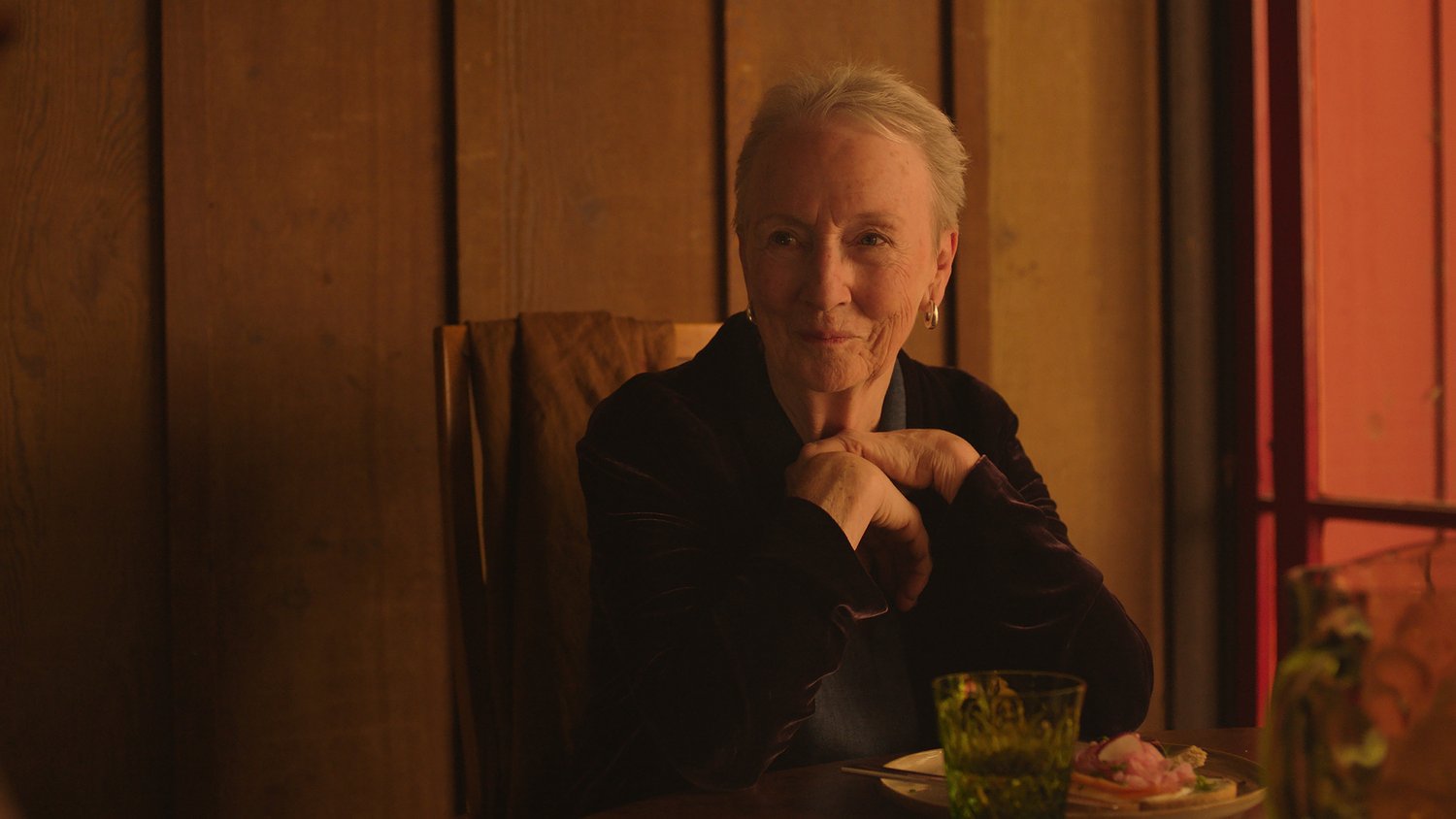Images courtesy of Music Box Films
FAMILIAR TOUCH— 4 STARS
Familiar Touch introduces a senior woman named Ruth, played by Kathleen Chalfant of Old and Duplicity, working in her modest home. She’s torn momentarily on what to wear to start the day, flipping through the hanging garments in her closet. Once settled, Ruth moves to the kitchen and begins to prepare a pair of open-faced breakfast sandwiches. The preparation looks intricate and delicious. Ruth seems fine in her home until she takes a piece of toast, turns from the counter, and slots it into the vertical dish rack over the sink, as if it were a plate to dry.
As a viewer of Familiar Touch, we catch it, and our head tilts a bit. Maybe Ruth, as a cook or chef, has some special technique for toast prep we don’t know about. She goes back to her room for another outfit change and greets her breakfast guest, a bearded middle-aged man with glasses and thinning hair (Bob’s Burgers voice actor H. Jon Benjamin). After she forgets his name and profession, he reintroduces himself as Steve, an architect. Answering his questions, Ruth is surprised he seemingly knows so many details about her, her husband, and her father. Gladdened, she affectionately puts her hand on his knee, almost in a pursuantly romantic fashion.
That move switches the mood of Familiar Touch. This man knows enough details, where we ascertain that Steve is her son, and she doesn’t know it. As they move to the car for a ride, he’s whisking her off to a senior living center, not a hotel for a getaway. When they arrive for the check-in, Steve changes the way he talks to Ruth. He drops the “Mom” line to get her attention, and the atmosphere again moves to something more and more fragile.
Ruth, nor the film, ever goes back for that slice of toast in the dish rack.
LESSON #1: A DIFFERENT TYPE OF ALZHEIMER’S MOVIE— From that tender opening scene, the stage is set for writer-director Sarah Friedland’s sophomore feature film. There is no musical score. There is no voiceover or narration. Only through body language, words, and actions do we know what Ruth is feeling and thinking. Unlike other common stories for similar films, the descent Ruth has taken into dementia has already happened. This isn’t the type of movie where we painfully watch a character lose their grasp on reality with monologues and mistakes alongside family characters fighting to keep their loved one engaged in the present with their fullest faculties. The crowd-swelling fight is long over.
No, Familiar Touch is about the transition into a different normalcy for this proud woman. Director of photography Gabe Elder (The Sparks Brothers) uses the running time here to voyeuristically follow Ruth as she acclimates herself to new surroundings. She can try the line of “I’m not one of those elderly people you have to watch constantly,” but we already know that’s not the case, or Steve wouldn’t be here. Forgotten in her memory, Ruth actually chose and arranged this place several months ago on a previous tour. They’ve been expecting her and Steve, and today is the day for Room 318 to get its new tenant. Rus
LESSON #2: SETTING NEW ROUTINES FOR THOSE WHO CANNOT RETAIN NEW ROUTINES— Ruth is assigned to a nurse named Vanessa (Carolyn Michelle of TV’s The Chi) the physician Brian (Andy McQueen, seen soon in Spike Lee’s Highest 2 Lowest alongside Denzel Washington), who will see to her care. As we see when Ruth is pointed to a table in the dining hall, sits down asking for a menu, only to meet and question the cook (Mike G. of The Way Back), we see this is going to take some time. That’s certainly the case the next day when Ruth, remembering her old life, grabs an apron, heads to the kitchen, and reinvents the morning breakfast with a new flair as if it’s a day at work in “her” kitchen 40 years ago.
LESSON #3: THE PATIENCE REQUIRED OF CAREGIVERS— Even at a film’s selective pace to go through this adjustment period for its protagonist, Familiar Touch informs us on the prescribed purposes and, even greater, the immense patience required of good caregivers in facilities like this. What goes on might not be exciting or life-changing, but when done right, the way of life organized and built by the workers maintains a person’s dignity and value through conveyed patience. While there are likely plenty of abusive horror stories out there of harsher treatment at senior centers (even the cartoonish types like Ben Stiller’s character Hal in Happy Gilmore), kindness is at the forefront here in Friendland’s movie, where Carolyn Michelle’s performance is as wonderful and nuanced as Chalfant’s in the lead.
Filming for Familiar Touch was done in collaboration with the residents and staff of Villa Gardens Continuing Care Retirement Community in New York. Backed by casting agent Betsy Fippinger (Eighth Grade and Are You There God? It’s Me Margaret), 67 residents, 13 staff members, and 12 caregiving and geriatrician consultants were credited for their involvement in making the movie, granting a tangible and uplifting authenticity that we’re being shown a positive standard of care and not an entirely sugarcoated movie version, just to perk up a plot with conflict.
LESSON #4: THE REALIZATION OF TRUTH— Vanessa’s line of “Your truth and ours are just a little different, and that’s OK” rings truest of all intentions laid by the film. Realization of the truth comes and goes, which can be difficult to comprehend from the outside looking in. Familiar Touch, without title cards, a calendar, or a clock to create any discernible—nor necessary, for that matter—passage of time, visits the different therapy and activity steps set up for Ruth, shown in a quiet montage arranged by Pachinko editor Aacharee Ungsriwong from water therapy to social time with fellow residents. Little exposition is given. It’s up to us to watch and learn as Ruth does.
And watch we do! Kathleen Chalfant’s creative and expressive character work in Familiar Touch is magnetic and appealing. Ever since that toast, we are attuned to watch her every move, and carry on that hope for improvement and success through the film. When she hits those goals to feel alive and useful, we feel them too and applaud the moments. Yet, mistakes and misunderstandings do come. In contrast, we’re never wallowing when the film is down either, thanks to the wide appreciation given to the setting used for Familiar Touch. In a rare development, the setting goes on to warm our hearts as much as the woman we’ve come to know walking its hallways.
LOGO DESIGNED BY MEENTS ILLUSTRATED (#1315)



